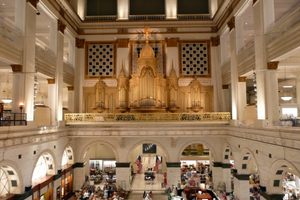About
Long before asphalt was the go-to replacement for cobblestones, city planners tried a number different materials to cover the roads including, in Philadelphia, wooden blocks.
The bustling streets of Philadelphia circa the 1830s were a noisy place. Chief among the cacophony was the sound of horse's hooves loudly clopping across the cobblestones, and a solution had to be devised. Thus the local businessmen teamed up with the city government and together they came up with the idea of paving the streets with sound-absorbing wooden blocks instead of resonating cobbles. Thus a number of the city streets were refinished with wooden paving using blocks of pine and oak, effectively muffling one of the largest sources of noise pollution of the day. Unfortunately sound was not the only thing the wooden streets absorbed.
The blocks quickly began to soak up every bit of liquid that fell on them from rain to copious amounts of horse urine. In addition to expanding and warping into a bumpy mess, the roads became unbearably smelly (especially in the summer) as the pee-soaked blocks rotted and crumbled. The trend of wooden roads quickly fell out of favor, and by the time automobiles hit the scene, they were all but gone.
However on the tight little 200 block of Camac Street, the wooden avenues remained. The area having developed into an artsy little enclave during the 20th century, the wooden roads were seen as a quaint oddity, but by the 1990s they had fallen into a dreadful state. Luckily, conservationists took an interest in the city's only remaining wooden road and had it redone with treated wooden blocks that will hopefully last longer than their predecessors. And smell better too.
Related Tags
Community Contributors
Added By
Published
February 19, 2015
Sources
- http://www.odditycentral.com/travel/pathways-to-the-past-americas-wood-paved-streets.html
- http://www.curatorofshit.com/the-wood-streets-of-philadelphia-pennsylvania/
- http://www.ocfrealty.com/naked-philly/washington-square-west/camac-little-wooden-street-could
- http://hiddencityphila.org/2014/03/little-clubs-on-a-wooden-street/
- The Philadelphia Inquirer, Friday, February 28, 1997. "What's unique about this splinter of a street?" by Mark Davis; The Philadelphia Inquirer, October 23, 1998, "Problems Surface to Slow Repaving of Camac Street" by Mark Davis.
- http://articles.philly.com/2015-12-26/entertainment/69302529_1_camac-street-south-philadelphia-asphalt


























